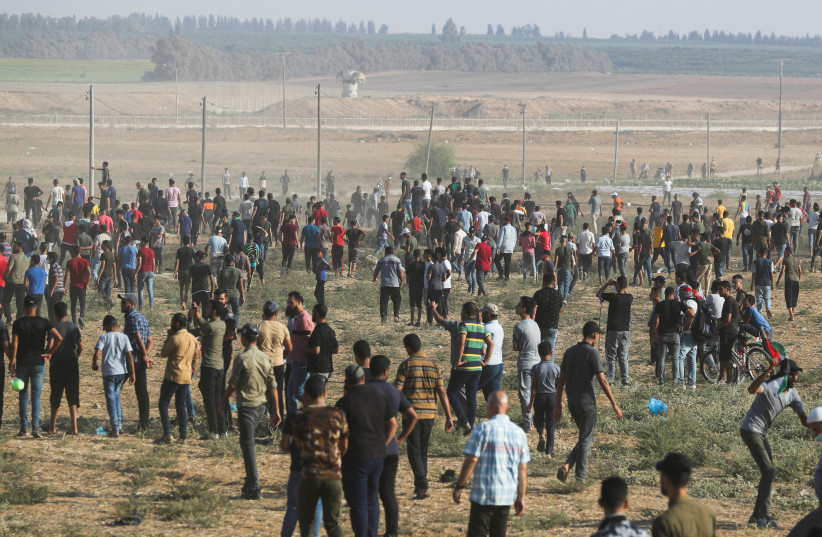The unbelievable ease with which an armed Hamas terrorist was able to brazenly approach Israel’s concrete defensive barrier that separates Israeli territory from the Gaza Strip, insert the barrel of his handgun into the narrow slit in the concrete and just blindly shoot, at close range, a border policeman, raises many serious questions.
By the same token, one may also ask how and why a regular phenomenon has been allowed to develop over the last few years by which large groups of violent, wildly incited Hamas demonstrators and armed terrorists, hysterically intent on infiltrating into Israel with the aim of harming Israeli soldiers and citizens, are able to so easily approach and storm Israel’s security barrier.
One of the central security elements of the 1995 Israeli-Palestinian Interim Agreement (commonly termed “Oslo II”) was the creation of what was called the “Delimiting Line” along the entire northern and western edges of the Gaza Strip, separating the Strip from Israel’s sovereign territory.
Part of this central security element was the establishment of a “Security Perimeter” adjacent to that line, within the Gaza Strip, hundreds of meters wide. In that Security Perimeter, the PLO and Israel agreed that the Palestinian police would exercise “security responsibility for preventing infiltrations across the Delimiting Line or the introduction into the Security Perimeter of any arms, ammunition or related equipment.”
Following Israel’s 2005 unilateral disengagement from the Gaza Strip and Hamas’s violent expulsion of the Palestinian Authority and forced takeover of the Strip in 2007, those essential components of the security arrangements relating to the Gaza Strip appear to have been replaced by a glaring security vacuum along the perimeter line with Israel. Add to this the tense security reality between Israel and Hamas that has existed over the years, with clashes, riots, violent mass demonstrations and, to cap it all, eruptions of fighting in operations Cast Lead (2008), Protective Edge (2014) and Guardian of the Walls (2021).
The irony of this situation is that Hamas has utilized and abused and continues to utilize and abuse this very same security perimeter for precisely the opposite purpose to that for which it was established. They have turned it into a zone for organized disorder and violence, a zone in which they sponsor, encourage, and organize periodic mass, violent demonstrations, as a staging area for attempted infiltrations, and as a means to periodically pressurize Israel, to attract international attention, and to bribe Egypt, the UN, Qatar and others to provide money and other forms of material and financial support.


Clearly, such a glaring vacuum in the security situation along the edge of the Gaza Strip, if allowed to continue, and if not filled by Israel with appropriate, alternative, and effective military and intelligence mechanisms, including whatever electronic and other measures are necessary to counter mass demonstrations and violence, is nothing more than an open invitation, a carte blanche, for further abuse by Hamas.
The question arises whether it would not be overly naïve to suggest to those international entities mediating between Israel and Hamas (Egypt, UN and Qatar, among others) that under any arrangement between the parties, Hamas be required to commit to reviving the security perimeter in the same format as the appears in the interim agreement, and to deploy its own police forces in order to prevent attempted infiltration and violent incidents.
Alternatively, another option could be the deployment in this security zone of a foreign police presence such as the multinational force and observers (MFO), which is already present in the area, or even an Egyptian or Qatari police presence. Such presence would likely restrain Hamas from exploiting the separation line area for pressure or for the purpose of heating up the area.
The author served as the legal adviser to the Foreign Ministry and as ambassador to Canada. He presently heads the Institute for Contemporary Affairs and the International Law Program at the Jerusalem Center for Public Affairs.
